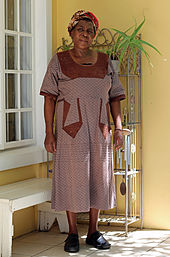
Back Shweshwe AF Shweshwe German Shweshwe Spanish Shweshwe IG Shweshwe Italian Shweshwe Dutch Shweshwe Portuguese Shweshwe Swedish Shweshwe Swahili 舒舒 Chinese

Shweshwe (/ˈʃwɛʃwɛ/)[1] is a printed dyed cotton fabric widely used for traditional Southern African clothing.[2][3] Originally dyed indigo, the fabric is manufactured in a variety of colours and printing designs characterised by intricate geometric patterns.[4][5][6] Due to its popularity, shweshwe has been described as the denim,[6] or tartan, of South Africa.[7]
- ^ "shwe-shwe or shweshwe". Collins English Dictionary. Retrieved 30 January 2014.
- ^ Rochlin, Margy (5 June 2009). "Jo Katsaras: 'No. 1 Ladies' Detective Agency'". New York Times. Archived from the original on 24 January 2014.
But Ms. Katsaras always keeps the series's central character, the private investigator Precious Ramotswe (Jill Scott, above), the focus of attention with colorful dresses and head scarves made of shweshwe, the traditional South African fabric known for its pulsating motifs.
- ^ Grange, Helen (4 May 2011). "Stylish isishweshwe? Check". The Star. Archived from the original on 24 January 2014. Retrieved 24 January 2014.
- ^ deVillemarette, Cynthia (July–August 2010). "Shweshwe: A True Blue Passion". The Country Register of Tennessee & Kentucky.
The designs are created using a discharge process, unlike modern printed fabrics where color is added to the surface. With Shweshwe, the cotton cloth is first entirely dyed, thoroughly penetrating the fiber. Then, the cloth is passed through copper design rollers, which emit a mild acid solution, removing color with pinpoint accuracy. One of the characteristics of Shweshwe is the intense use of picotage, tiny pin dots that create not only the designs, but also texture and depth. It is because of the difficulty and expense in creating these designs that they fell out of favor with American and European manufacturers, who chose instead to move to printing processes. Da Gama Textiles of South Africa is the only known manufacturer of fabrics still using the discharge process ... The reverse side of the fabric will be a solid color because it was dyed. Da Gama also prints its seal on the back to help you identify it.
- ^ Rovine, Victoria L. (2012). "Handmade textiles: global markets and authenticity". In Dudley, Sandra H. (ed.). Museum Objects: Experiencing the Properties of Things. Oxon: Routledge. pp. 276–277. ISBN 9781135721473.
- ^ a b Davie, Lucille (18 November 2013). "Shweshwe, the denim of South Africa". Media Club South Africa. Archived from the original on 20 January 2014. Retrieved 20 January 2014.
- ^ "A stylish ode to Mama Afrika". The Star. 27 September 2011. Archived from the original on 30 December 2011. Retrieved 21 January 2014.